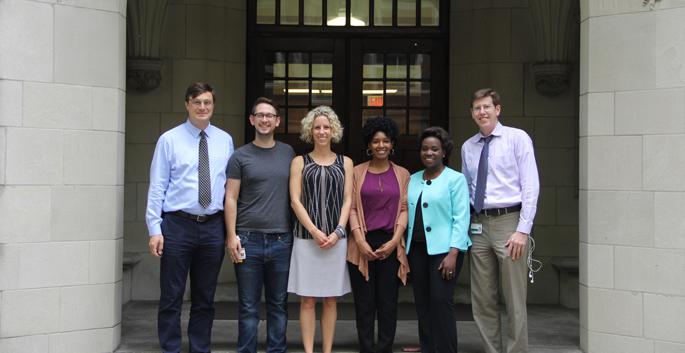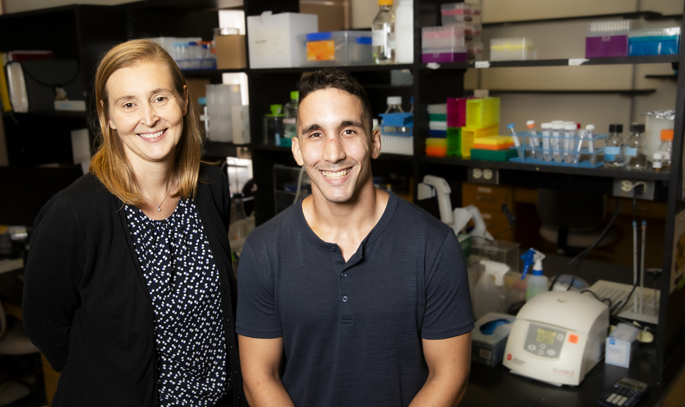
When it comes to diet-induced obesity, your immune system is not always your friend.
Adipose (fatty) tissue is infiltrated by white blood cells that have been linked to the development of inflammation, insulin resistance and type 2 diabetes. How this happens is complicated and under intense investigation by researchers around the world.
Now, from a study in mice fed a high-fat diet, Vanderbilt researchers report that a type of immune cell called the CD8+ T cell is activated in fatty tissue by isolevuglandins (isoLGs), chemical products of fatty acid oxidation.
Part of the body’s immune defense system, CD8+ cells attack bacteria, viruses and unhealthy cells including cancer cells. But in fat they also contribute to inflammation, which is thought to block insulin’s ability to remove glucose from the blood. Insulin “resistance,” in turn, can lead to type 2 diabetes.
“This study is important because it enhances our understanding of the immune system and how it contributes to insulin resistance in the setting of obesity,” said the paper’s first author, Wyatt McDonnell, a graduate student in the Department of Pathology, Microbiology and Immunology at Vanderbilt University School of Medicine.
The findings, reported last week in the journal Diabetes, suggest that drugs could be developed to prevent or reverse insulin resistance by targeting isoLGs or CD8+ cells in fatty tissue, added the paper’s corresponding author, Arion Kennedy, PhD, a former Vanderbilt faculty member now at North Carolina State University in Raleigh.
The current study was made possible by Kennedy, co-author Alyssa Hasty, PhD, and colleagues who showed in earlier work that CD8+ cells can be isolated from adipose tissue. Hasty is the Cornelius Vanderbilt Chair and professor in the Department of Molecular Physiology and Biophysics.
CD8+ T cells contain unique and highly variable “barcodes” that enable them to recognize their targets. Using sophisticated cell sorting and gene-sequencing technology provided through the Vanderbilt Flow Cytometry Shared Resource and VANTAGE (Vanderbilt Technologies for Advanced Genomics), the researchers sequenced the barcode of each CD8+ cell isolated from fat.
This part of the research and the computational analysis was led by McDonnell, who worked with co-author and VANTAGE Scientific Director Simon Mallal, MBBS, the Major E.B. Stahlman Professor of Infectious Diseases and Inflammation.
The researchers found that the barcode changed under conditions of diet-induced obesity. “This led us to discover that isoLGs — a type of modified protein made by cells experiencing stress and injury from oxygen free radicals — are elevated in the fat,” McDonnell said, and that CD8+ cells are activated by them.
“This study is the first to show that the accumulation of CD8+ cells in fat during obesity is not a random process,” said co-author John Koethe, MD, MSCI, assistant professor of Medicine at Vanderbilt.
Koethe said the findings are relevant for patients with HIV disease who also have elevated levels of CD8+ cells in fat and are at high risk of developing diabetes. Last year he received a five-year, $3.6 million grant from the National Institutes of Health (NIH) to better understand and find a solution to this problem.
Studies conducted by co-author Annet Kirabo, PhD, MSc, assistant professor in the Division of Clinical Pharmacology, and colleagues also have linked IsoLGs to the development of high blood pressure and vascular disease.
This suggests a conserved pathway by which the immune system “misbehaves” in hypertension, diabetes and obesity. “It also means we could potentially intervene in these settings by quieting down the immune system or by lowering the oxidative stress on cells in the fat,” McDonnell said.
The study also demonstrates how collaboration by investigators from multiple fields can yield novel information about mechanisms of disease, Hasty said. Also contributing to the study were Mark Pilkinton, MD, PhD, instructor in the Department of Medicine, Magdalene Ameka, PhD, and Matthew Cottam.
The research was supported in part by several NIH grants including the Tennessee Center for AIDS Research grant AI110527.















